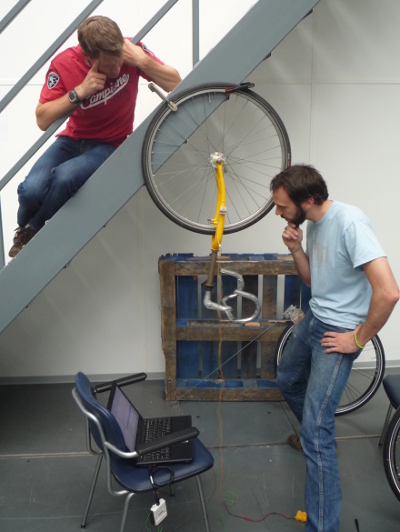
Summary
To accurately model the bicycle and rider system, the basic physical parameters of the bicycle and the rider must be measured or estimated. These parameters include the geometry, mass, mass locations, and mass distribution of all the bodies in the system at the most basic level and but may include any other constants such as frictional coefficients, damping constants, etc. Starting at TU Delft with Jodi Kooijman's tools and methods, I refined a technique for measuring both the bicycle and rider's basic parameters.
Software
PhysicalParameters
This is the original implementation of BicycleParameters that I created to learn Python. It isn't well documented, but available for historical sake.
Data
The data for all of the bicycles presented in my dissertation are available for download from Figshare:
Moore, Jason; Hubbard, Mont; Kooijman, J. D. G.; Schwab, A. L. (2014): Bicycle Parameters. figshare. http://dx.doi.org/10.6084/m9.figshare.1198429
Publications
- Jason K. Moore. Human Control of a Bicycle". PhD thesis. Davis, CA: University of California, Davis, Aug. 2012. http://moorepants.github.io/dissertation
- Jason K. Moore et al. An Accurate Method of Measuring and Comparing a Bicycle's Physical Parameters". In: Proceedings of Bicycle and Motorcycle Dynamics: Symposium on the Dynamics and Control of Single Track Vehicles. Delft, Netherlands, Oct. 2010.
- Jason K. Moore et al. A Method for Estimating Physical Properties of a Combined Bicycle and Rider". In: Proceedings of the ASME 2009 International Design Engineering Technical Conferences & Computers and Information in Engineering Conference, IDETC/CIE 2009. ASME. San Diego, CA, USA, Aug. 2009.
Talks
- MAE Exit Seminar, Davis, CA, USA, Human Control of a Bicycle, May 15, 2012
- UCD MAE Qualifying Exam, Davis, CA, Human Control of a Bicycle October 9, 2009
- ASME IDETC/CIE 2009, San Diego, CA, A Method for Estimating the Physical Properties of a Combined Bicycle and Rider, August 31, 2009
Grant Information
This material is partially based upon work supported by the National Science Foundation under Grant No. 0928339. Any opinions, findings, and conclusions or recommendations expressed in this material are those of the authors and do not necessarily reflect the views of the National Science Foundation.

